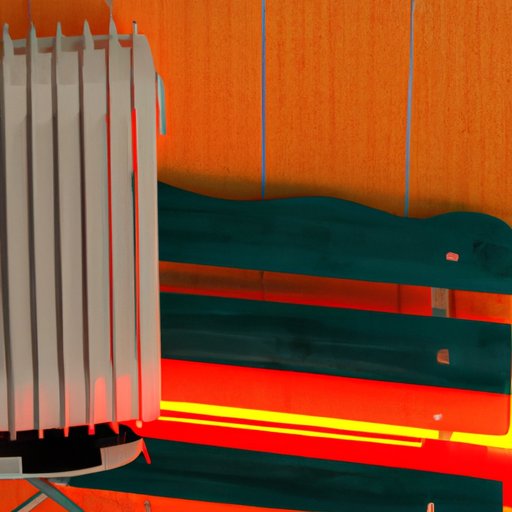Introduction
Infrared heating is a method of providing warmth through electromagnetic radiation. It works by emitting invisible rays that directly heat objects instead of air molecules like traditional heating systems do. This article will explain the science behind infrared heating, demonstrate how it works, detail the benefits of using an infrared heater, compare traditional heaters with infrared heaters, showcase different types of infrared heaters, discuss safety tips for using infrared heaters, and highlight popular uses for infrared heaters.
Explain the Science Behind Infrared Heating
The electromagnetic spectrum is the range of frequencies of electromagnetic radiation and their associated wavelengths and photon energies. Visible light is just one form of this electromagnetic radiation – other forms include radio waves, microwaves, x-rays, and ultraviolet and infrared radiation.
Infrared radiation falls between microwaves and visible light on the electromagnetic spectrum, and it is what gives us the warm radiation we feel as heat. It is emitted by all objects with temperatures above absolute zero and absorbed by other objects. The wavelength ranges from 0.75 to 1000 micrometers, and it is divided into three categories: near, mid, and far infrared.
Near infrared radiation has the shortest wavelengths and highest energy, while far infrared radiation has the longest wavelengths and lowest energy. Infrared heaters use far infrared radiation to generate warmth without the need for convection or conduction. They emit a specific frequency of infrared radiation which is then absorbed by people and objects in the room, heating them up.
Demonstrate How an Infrared Heater Works
An infrared heater consists of several parts and components. At the heart of the system is the heating element, which is usually made of ceramic or quartz. This element is heated up to a high temperature and emits infrared radiation when energized. The heat is then directed at the target area by a reflector, which ensures that most of the radiation is concentrated in the desired area.
The illustration below shows the process of how an infrared heater works. The electric current flows into the heating element and heats it up. The element then emits infrared radiation which is reflected back by the reflector. The radiation is then absorbed by people and objects in the room, warming them up.

Detail the Benefits of Using an Infrared Heater
Infrared heaters offer several benefits over traditional heating systems. The first is energy efficiency. Because the heat is generated directly in the target area, less energy is lost in transit. This means that you can save money on your energy bills by using an infrared heater.
Another benefit of infrared heaters is that they are more cost-effective than traditional heating systems. They require less maintenance and installation costs, and they last longer than traditional heating systems. Additionally, because the heat is generated directly in the target area, there is no need for ducts or vents.
Finally, infrared heaters provide a healthier form of heat. Traditional heating systems rely on hot air to warm up a room, which can dry out the air and cause allergies and other health issues. On the other hand, infrared heaters generate a gentle, consistent warmth that is easier on the body.

Compare and Contrast Traditional Heaters with Infrared Heaters
When comparing traditional heaters with infrared heaters, there are several key differences. One difference is in terms of temperature control. Traditional heaters rely on hot air to warm up a room, so they are not able to accurately regulate the temperature. On the other hand, infrared heaters generate direct heat, so they can be used to precisely control the temperature of a room.
Another difference is in terms of installation requirements. Traditional heaters require complex ductwork and vents, whereas infrared heaters are much simpler to install. Finally, traditional heaters require regular maintenance and servicing, whereas infrared heaters require very little maintenance.

Showcase Different Types of Infrared Heaters
There are several different types of infrared heaters available on the market today. Portable infrared heaters are the most common type and are ideal for small spaces such as bedrooms and offices. Wall-mounted infrared heaters are another option and are great for larger areas such as living rooms and kitchens. Ceiling-mounted infrared heaters are the most powerful option and are best suited for industrial and commercial applications.

Discuss Safety Tips for Using Infrared Heaters
Infrared heaters should be used with caution. To prevent accidents, always keep objects at least three feet away from the heater. Additionally, have a fire extinguisher nearby in case of a fire. Finally, make sure the area is properly ventilated to avoid carbon monoxide poisoning.

Highlight Popular Uses for Infrared Heaters
Infrared heaters have many practical applications. They are commonly used for home heating, outdoor heating, and industrial heating. They are also popular for spot heating in large facilities such as warehouses and factories. In addition, they are often used in saunas and hot tubs to provide a comfortable and relaxing environment.
Conclusion
In conclusion, infrared heaters are an efficient and cost-effective way to heat a space. They generate direct heat which can be precisely controlled, and they require minimal maintenance and installation costs. Additionally, they are safe to use if the proper precautions are taken. Infrared heaters are popular for home heating, outdoor heating, and industrial heating, as well as spot heating in large facilities.
This article has provided an overview of how infrared heaters work and the benefits they offer. With this knowledge, you can now make an informed decision about whether an infrared heater is the right choice for your needs.
(Note: Is this article not meeting your expectations? Do you have knowledge or insights to share? Unlock new opportunities and expand your reach by joining our authors team. Click Registration to join us and share your expertise with our readers.)
